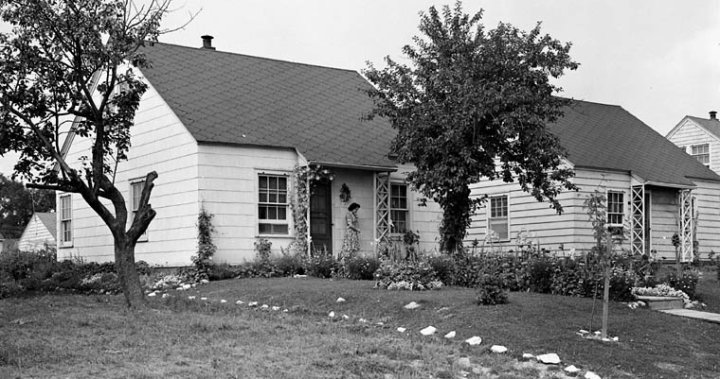The federal government is looking to the past to create a roadmap for the future of housing policy in Canada.
Federal housing minister Sean Fraser on Tuesday confirmed Global News’ report from Monday that the minority Liberals were taking a nearly 80-year-old program off the shelf and revamping it.
When thousands of veterans returned to Canada after the Second World War, Canada was facing a housing crisis. To cut through the red tape and accelerate the building and approval process, Ottawa released a catalogue of pre-approved home designs that builders could start constructing straight away. Hundreds of thousands of new homes were built in Canada over a short period of time.
“In many instances, these homes were being built in a period of about 36 hours, and we intend to take these lessons from our history books and bring them into the 21st century,” Fraser told reporters in Ottawa.
“We are going to be moving forward with a catalogue of pre-approved designs at the federal level.”
At the heart of the Second World War-era policy is the ‘Strawberry-box home’ or ‘Victory home’, a type of house built for returning war veterans and their families. They were named for the shape of boxes in which strawberries were sold at grocery stores.
“The typical design in the 1950s was a single-family home, usually a bungalow, maybe one and a half stories, maybe one story. They were called strawberry boxes,” said housing policy expert Carolyn Whitzman, “They looked like the little baskets that you put strawberries in.”
Much of the construction in the post-war years was done by a Crown corporation called Wartime Housing Canada, which later became the Canada Mortgage and Housing Corporation (CMHC).
James McKellar, professor emeritus of real estate and infrastructure at York University’s Schulich School of Business, grew up in a house that came with a pre-approved design. “It was bare bones because the focus was on getting people into homes, not satisfying their luxury ambitions,” he said.
“If you go through any city today, whether Calgary, Edmonton, Toronto, Vancouver, there are vestiges of these small houses,” he said.
The homes were also much smaller than the average single-family home today. A design catalogue dated April 1954, which Global News accessed, shows they range between 700 and 1,000 square feet, with the majority of designs being between 800-900 square feet. In contrast, McKellar said today’s homes can be upwards of 2,000 square feet.
Adapting to a changing Canada
Both experts agreed that the new catalogues would have to look a lot different. The pre-approved designs in 1954 were mostly single-family homes. The catalogue listed 70 designs in a few different types of bungalows – two-bedroom, three-bedroom and four-bedroom.
Experts argue that 21st-century Canada needs more diverse housing.
“We’d want to have four, six, eight, 12-story apartments that are able to be built close to public transit. I think the place where you’d start with would be apartment buildings,” Whitzman said.
Eric Lombardi, founder of the Toronto-based housing advocacy group More Neighbours Toronto, said that several policy changes at the municipal, provincial and federal levels have encouraged the building of “missing middle” housing – that is housing that is neither single-family homes nor giant condo towers. However, he said the private sector has not caught up.
“The industry doesn’t really have a, let’s call, the muscle memory of building this kind of housing. And so that’s why I think the focus (of pre-approved designs) on that missing middle format is so important. And it’s low-hanging fruit to solve,” he said.
Fraser’s vision for the modern revamp will include various styles of homes.
“I will be looking for pre-approved designs for multiplexes, for mid-rise buildings, for student housing, for seniors, residences and other small to medium-scale residential properties,” he said.
“This will include garden suites and laneway homes and different kinds of houses that will solve the challenges that our communities are facing today.”
McKellar said, “In order to bring down the cost, you’ve got to strip away some stuff. I think having multiple forms of housing, whether duplex or student housing, is a great idea.
Factory-built future homes
Whitzman said having pre-approved designs would lead to a boom in factory-made homes. “You can start prefabricating components. You can start having factory-built products,” she said.
In addition to improved working conditions for people in the trades, who currently often work outside on job sites, Whitzman said this would significantly increase construction season. Most of the components of the house could be built indoors, in a factory, and assembled on-site.
“After the war, there were homes built in as little as 36 hours. Even today, you could have these prefabricated components built in place within a week or so, depending on the complexity of the project,” she said.
Another country that successfully built pre-approved homes rapidly was Sweden. The country’s Million Homes Program, between 1965 and 1974, built housing rapidly across the country. It also led to the rising fortunes of one of the country’s most iconic furniture brands — IKEA.
“Once you have a certain size of living room, a certain size of kitchen, you can start having prefabricated components to go in the kitchen or in the living room, she said. “IKEA furniture was made to fit in that standardized size, and that brought the cost down enormously.”
Are ‘Strawberry-box homes’ dull?
A criticism of Sweden’s Million Homes Program is that it produced dull-looking architecture. A common joke is that one could easily stumble into the wrong home late at night, because they all look the same. But Whitzman says there are ways around it.
“Housing when it’s built in bulk can be a very homogenous-looking product. What can you do about that? You can do landscaping, you can do murals, you can do changes to the facades,” she said.
McKellar said during a research project many years ago, he posed a question to owners of homes with pre-approved designs. “My first question was, what was the first thing you renovated? And it was the front door. It was to put in a nice front door with a vestibule.”
He added, “I think there’s a huge opportunity for the federal government to look at what they did after the war and say, listen, our housing challenge today is just as great. And it’s going to take that kind of bold move to do it.”
While there will be many more pieces of the puzzle to come together to achieve the envisioned boom in construction, federal officials hope to get the ball rolling soon. Fraser said consultations on the matter are set to begin in the new year, with the goal of having the catalogue available for developers next fall.
— with files from Global’s Aaron D’Andrea




